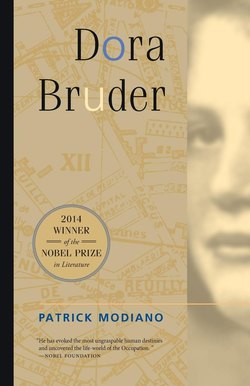Читать книгу Dora Bruder - Patrick Modiano - Страница 11
На сайте Литреса книга снята с продажи.
Оглавление.................
ERNEST BRUDER, BORN VIENNA, AUSTRIA, 21 MAY 1899. His childhood would have been spent in that city’s Jewish quarter, Leopoldstadt. His own parents were almost certainly natives of Galicia or Bohemia or Moravia, having come, like the majority of Vienna’s Jews, from the eastern provinces of the Empire.
I had turned twenty in Vienna, in 1965, also the year when I was frequenting the Clignancourt districts. I lived on the Taubenstummengasse, behind the Karlskirche. My first few nights were spent in a seedy hotel near the Western Station. I have memories of summer evenings spent in Sievering and Grinzing, and of parks where bands were playing. And, not far from Heilingenstadt, of a shack in the middle of some sort of allotment. Everything was closed on those July weekends, even the Café Hawelka. The city was deserted. Tramlines glistened in the sunlight, crisscrossing the northwestern districts as far as Pötzleinsdorf Park.
Some day, I shall go back to Vienna, a city I haven’t seen for over thirty years. Perhaps I shall find Ernest Bruder’s birth certificate in the Register Office of Vienna’s Jewish community. I shall learn his father’s first name, occupation, and birthplace, his mother’s first name and maiden name. And whereabouts they had lived in that zone of the 2d district, somewhere between the Northern Station, the Prater, and the Danube.
Child and adolescent, he would have known the Prater, with its cafés, and its theater, the home of the Budapester. And the Sweden Bridge. And the courtyard of the Commodities Exchange, near the Taborstrasse. And the market square of the Carmelites.
In 1919, his life as a twenty-year-old in Vienna had been harder than mine. Following the first defeats of the Austrian army, tens of thousands of refugees fleeing from Galicia, Bukovina, and the Ukraine had arrived in successive waves to crowd into the slums around the Northern Station. A city adrift, cut off from an empire that had ceased to exist. Ernest Bruder must have been indistinguishable from those bands of unemployed roaming the streets of shuttered shops.
Or did he come from a less poverty-stricken background than the refugees from the east? The son of a Taborstrasse shopkeeper, perhaps? How are we to know?
On a file card, one of thousands in an index created some twenty years later to facilitate the roundup of Jews during the Occupation, and which still lies around to this day at the Veterans’ Administration, Ernest Bruder is described as “French legionnaire, 2d class.” So he must have enlisted in the Foreign Legion, though I have no means of knowing precisely when. 1919? 1920?
A man enlisted for five years. He didn’t even need to go to France, it was enough to visit a French consulate. Was that what Ernest Bruder did, in Austria? Or was he already in France by then? Either way, along with other Germans and Austrians in his situation, he was probably sent to the barracks at Belfort and Nancy, where they were not exactly received with open arms. Then it was Marseille and the Fort Saint-Jean, where the reception was cooler still. After that, the troopship: in Morocco, it seemed, Lyautey was short of thirty thousand troops.
I’m trying to reconstitute Ernest Bruder’s tour of duty. The bounty, handed out at Sidi Bel Abbès. The condition of most enlisted men—Germans, Austrians, Russians, Rumanians, Bulgarians—is so miserable that they are dazed by the idea of receiving a bounty. They can’t believe their luck. Hastily, they stuff the money into their pockets, as if it might be taken back from them. Then comes the training, long runs over the dunes, interminable marches under a leaden African sun. For volunteers from Central Europe, like Ernest Bruder, it is hard going: they have been undernourished throughout adolescence, owing to four years of wartime rationing.
Next, the barracks at Meknès, Fez, or Marrakesh. They are sent on operations intended to pacify the still rebellious territories of Morocco.
April 1920. Fighting at Bekrit and the Ras-Tarcha. June 1921. Legion battalion under Major Lambert engaged in the Djebel Hayane. March 1922. Fighting at Chouf-ech-Cherg. Captain Roth. May 1922. Fighting at Tizi Adni. Nicolas battalion. April 1923. Fighting at Arbala, and in the Taza corridor. May 1923. Heavy fighting for the Talrant Bab-Brida, taken under intense fire by Naegelin’s legionnaires. On the night of the 26th, in a surprise attack, the Naegelin battalion occupies the Ichendirt massif. June 1923. Fighting at Tadout. Naegelin battalion takes the ridge. Legionnaires raise the tricolor over an important casbah to the sound of bugles. Fighting at Oued Athia, where the Barrière battalion has to make two bayonet charges. Buchsenschutz battalion takes entrenched positions on the pinnacle south of Bou-Khamouj. Fighting in the El-Mers basin. July 1923. Fighting on the Immouzer plateau. Cattin battalion. Buchsenschutz battalion. Susini and Jenoudet battalions. August 1923. Fighting at Oued Tamghilt.
At night, in this landscape of stone-strewn sand, did he dream of Vienna, the city of his birth, and the chestnut trees of the Hauptallee? The file of Ernest Bruder, “French legionnaire, 2d class” also indicates: “100% disabled.” In which of these battles was he wounded?
At the age of twenty-five, he was back on the streets of Paris. The Legion must have released him from his engagement because of his war wound. I don’t suppose he talked about it to anybody. Not that anybody would have been interested. I’m almost sure he didn’t receive a disability pension. He was never given French nationality. In fact, I’ve seen his disability mentioned only once, and that was in one of the police files designed to facilitate the roundups during the Occupation.
